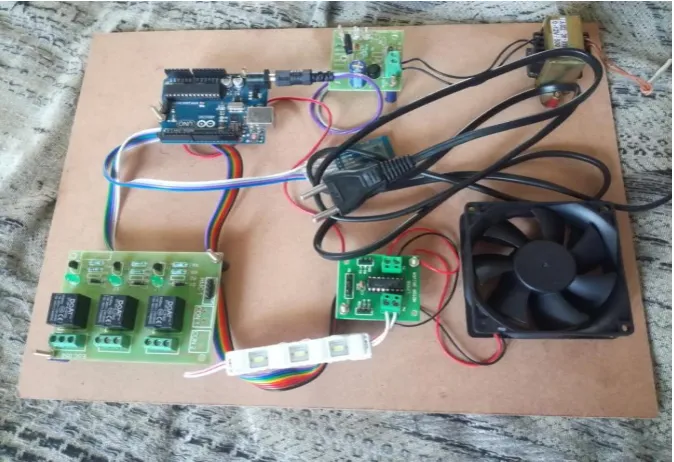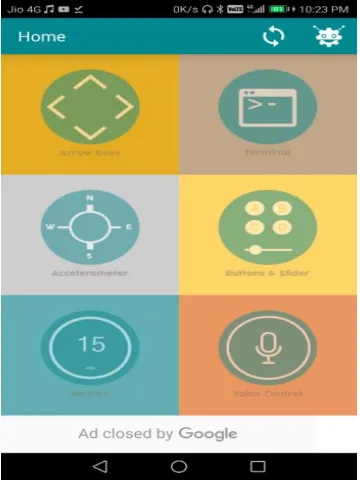6
I
January 2018
Voice Controlled Home Automation by using
Bluetooth Module
M.Srinivasan1, T. Vetrivendan2, M. Veeraprasanth3, B. Karthikeyan4 1
Assistant Professor Department of EEE Kongu Engineering College Perundurai.
2, 3, 4
IV Year Students Department of EEE Kongu Engineering College Perundurai.
Abstract: This project presents the development of home appliances based on voice command using Android. This system has been designed to assist and provide the support to elderly and disabled people at home. Google application has been used as voice recognition and process the voice input from the smart phone. In this project, the voice input has been captured by the android and will be sent to the Arduino Uno. Bluetooth module in Arduino Uno will receive the signal and process the input signal to control the light and fan. The proposed system controls electrical appliances with relatively user-friendly interface and ease of installation. We have demonstrated up to 20 meter of range to control the home appliances via Bluetooth.
I. INTRODUCTION
The home automation system (HAS) concept has existed in the emerging market and becoming popular nowadays. Due to the advancement of wireless technology, there are several different of connections was introduced such as global system for mobile communications (GSM), WiFi, ZigBee and Bluetooth. Each of the system has their own advantages and applications. Most of the systems used computer to control the home appliances. Furthermore, this situation is not relevant nowadays because the size of the computer is big and not easy to handle. As we know, PIC programming is quite difficult because we need to design our own circuit. GSM network system and internet has been implemented in HAS system The system using radio frequency (RF) communication protocol has a lower cost compared to other wireless communication methods such as Bluetooth. However Bluetooth has low power wireless signals and used frequency hopping spread spectrum (FHSS) modulation. This will help to avoid any interference from any other wireless devices and easy to communicate with various Bluetooth devices. Here we uses the smart phone as speech based remote control.
II. LITERATURE REVIEW
M. B. Othman [1] presented the paper titled “Voice Control of Home Appliances using Android”. This paper presents the brief idea about controlling of home automation by using Bluetooth technology through smart phone and Ardunio Uno.
A.R.Al-Ali [2] and M. Al-Rousan [3] were the first to develop Home automation system using java programming. It mainly used Wi-Fi as a medium for communication between software and hardware component. The main drawback was the range as the range of Wi-Fi was limited hence the user has to be within the range. An android based home automation was then developed. It used internet in the place of Wi-Fi and its disadvantage was Unavailability of Internet.
B.Chakradhar [4] and S. Krishnaveni [5] presented the idea of Bluetooth based Home automation. It used arm processor (ARM9 and ARM7), and so the system has a complex architecture.
R.Piyare [6] and M.Tazil [7] Department of Electrical & Electronics Engineering Fiji National University has explored the ieee paper titled “Bluetooth Based Home Automation System Using Cell Phone”. This paper gives the detailed information about how the and arduino and bluetooth module interfacing in the automation process.
III. EXISTING SYSTEM
The existing system contains Wi-Fi based using Arduino Microcontroller, Cloud Based Using Zig Bee Microcontroller, GSM based using PIC microcontroller.
A. The cost of these systems are high
B. These systems are complex in construction
IV. PROPOSED SYSTEM
Users can control the load by giving the input via the smart phone either by using touch button or voice command. We used a different character for identifying different function of the speed of fan and switch ON/OFF the light. This project is very easy to
use in real life. People of any age can control it by just speaking the commands.
A. Block diagram
Fig.1 Block Diagram
B. Components Used
1) Arduino UN
2) Bluetooth modul
3) Relay
4) Fan Load
5) Light Load
6) Android Bluetooth Controller
V. CONSTRUCTION
The Fig.2 shows the connection diagram of voice controlled bluetooth module. A single phase 230V AC supply is given to the 12V step-down transformer. A 12V AC is given to the rectifier bridge and AC is converted into DC. Then 12V DC is given to 5V regulator (LM 7805) and constant 5V is obtained. A 5V DC is given to the arduino and from the arduino bluetooth module is connected. A 5V DC output is given to the motor driver in order to control the speed of the fan and the remaining are given to the relays to turn on and off the appliances.
Fig.3 Hardware Working Model
A. Arduino UNO
B. Power Supply
C. One channel 5v relay
D. LED and FAN
E. Bluetooth Module(HC-05)
F. motor Driver( L293)
VI. SEQUENCE OF OPERATION OF APPLICATION
Step 1: The application seek a permission from the user whether to enable the Bluetooth or not.
[image:4.612.221.396.520.724.2]Step 2:To configure separate vocal command for the respective appliances
Figure 4 Configuring the Character
Step 3: This shows that to choose which type of controller is to establish.
Figure 5 Controller Established
[image:5.612.218.397.421.684.2]Step 4: The Voice Controller receives the vocal commands and send that data to the Bluetooth module which operates respective to the data received.
Figure 6 Reads according to the data received
Step 5: The Application disconnects the Bluetooth module .
Figure 7 Disconnect the Bluetooth Module
VII. RESULT AND DISCUSSION
[image:6.612.217.397.365.605.2]glowing at the half of that maximum illumination and the character assigned for that is E. If the "light off" command is given the LED turns off and the character assigned for that is F.
VIII.CONCLUSION
Voice Controlled Home Automation is a very different concept than what is presently available in the market. This would make automation easier. People will easily interact with the system. It is also an important aspect in the present world where people are so busy, this would help them in reducing the basic functionality of their life. The world around us is going digital in every aspect we can imagine and it is happening fast, we also need to move forward with it. Our system is a great initiative step in automation, it would also provide with security. As it is based on voice recognition we can assign particular password to each user and the automation will respond to the correct passwords only.
REFERENCES
[1] R. Al-Ali and M. Al-Rousan, proposed a paper Java-Based Home Automation System, vol. 50, no. 2, pp. 499-505, 2004.
[2] Alper Gurek, Caner Gur, Cagri Gurakin, Mustafa Akdeniz, Ilker Korkmaz, proposes An Android Based Home Automation System, 2014 11th International Conference on High Capacity Optical Networks and Enabling Technologies, December 2013.
[3] Thinagaran Perumal, Md Nasir Sulaiman, Khaironi Yatim Sharif, Abd Rahman Ramli, Chui Yew Leong, deilivers Development of an Embedded Smart Home Management Scheme, International Journal of Smart Home, Vol. 7, No. 2, March, 2014.
[4] D.Naresh, S.Krishnaveni, 'Bluetooth Based Home Automation and Controlling System', International Journals of Engineering and Trends, Vol. 4 Issue 9, September 2013.
[5] Mohamed Abd El-Latif Mowad, Ahmed Fathy, Ahmed Hafez, “Smart Home Automated Control System Using Android Application”, International Journal of Scientific &Engineering Research, Volume 5, Issue 5, May 2015.


